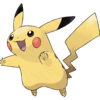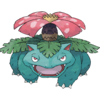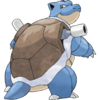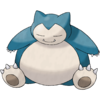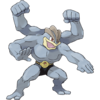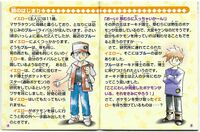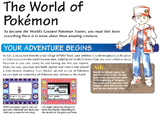User:Lewtwo/Red
| Red Navigation |
Character |
THE TAB SYSTEM IS CURRENTLY A WIP. SEE HERE FOR HOW THE TOP OF THE PAGE WILL LOOK
- This article is about the original game player character whose name was initially Satoshi. For his anime counterpart named Satoshi in Japan, see Ash Ketchum.
For the game paired with Pokémon Green Version, see Pokémon Red and Green Versions.
For the game paired with Pokémon Blue Version, see Pokémon Red and Blue Versions.
| Red レッド Red | |
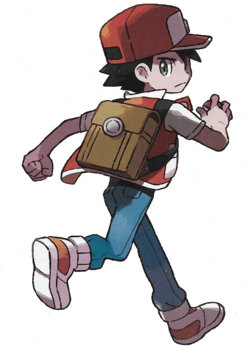 Artwork from Let's Go, Pikachu!, Let's Go, Eevee! by Megumi Mizutani[1] | |
| Age | 11RBYFRLG [2] 14GSCHGSS [3] 28B2W2 [4] 30SMUSUM [5] |
|---|---|
| Gender | Male |
| Eye color | Black*, Brown*, Gray* |
| Hair color | Black*, Brown* |
| Hometown | Pallet Town |
| Region | Kanto |
| Relatives | Mom, unnamed father |
| Trainer class | Pokémon TrainerRBYGSCFRLGHGSSB2W2SMUSUMPE player characterRBYFRLG Battle LegendSMUSUM |
| Generation | I, II, III, IV, V, VII |
| Games | Red, Green, Blue, Yellow, Gold, Silver, Crystal, FireRed, LeafGreen, HeartGold, SoulSilver, Black 2, White 2, Sun, Moon, Ultra Sun, Ultra Moon, Let's Go, Pikachu!, Let's Go, Eevee!, Stadium (JP), Stadium 2, Masters EX |
| Champion of | Indigo Plateau |
| Game animation debut | File 1: Red |
| English voice actor | Bryce Papenbrook (Origins) Brandon Winckler[6] (Masters EX) |
| Japanese voice actor | Junko Takeuchi (Origins) Shouta Aoi (Masters EX) |
| Anime counterpart | Ash Ketchum, Red |
| Counterpart debut | Pokémon - I Choose You! |
| Manga counterpart(s) | Red, Red, Red, Red, Ash, Ash, Satoshi, Shu |
Red (Japanese: レッド Red) is the player character in the Generation I games Pokémon Red, Green, Blue, and Yellow and the male choice in their Generation III remakes Pokémon FireRed and LeafGreen, where his female counterpart is Leaf. Prior to Generation II, he was officially referred to as Satoshi (Japanese: サトシ).
Red is known throughout the Pokémon world as the Champion from Pallet Town, as well as a living legend for his defeat of Team Rocket in Kanto during his quest. He is the final opponent in the Generation II games Pokémon Gold, Silver, and Crystal, their Generation IV remakes Pokémon HeartGold and SoulSilver, and Pokémon Stadium 2. He is a participant in the Pokémon World Tournament's Champions Tournament in Pokémon Black 2 and White 2 and works as a boss of the Battle Tree alongside Blue in the Generation VII games Sun, Moon, Ultra Sun, and Ultra Moon. In Pokémon: Let's Go, Pikachu! and Let's Go, Eevee!, he appears as the highest-level Trainer in the game, capable of being challenged after defeating six Master Trainers.
In the core series
Red is introduced as a curious 11-year-old boy from Pallet Town. According to the instruction manuals of Red, Green, and Blue, Red gained an interest in Pokémon after his best friend, Blue, stopped playing with him and became a bully, although in the games Professor Oak says the two have been rivals since infancy. His adventure begins one day when Professor Oak calls the two to his lab for a first partner Pokémon. Red has a choice of a Bulbasaur, Charmander, or SquirtleGRBFRLG. Depending on the Pokémon that Red chooses, Blue will choose the Pokémon that has a type advantage over itGRBFRLG. In Pokémon Yellow, Red was originally intended to get an Eevee, which was swiped by Blue. As a result, Blue keeps the Eevee and Red receives a Pikachu that Professor Oak caught earlierY. Blue challenges Red to a battle immediately to test out his new Pokémon, thinking he will easily beat Red.
After Red has made his way to Viridian City to the north and taken a package back to Oak in Pallet Town, Oak gives Red and Blue each a Pokédex with which to record data on all known Pokémon in the Kanto region to fulfill Oak's dream of creating a full guide on all Pokémon in Kanto. From here, Red and Blue journey across Kanto, collecting Pokémon to build up their teams, and defeating each of the Gym Leaders in turn, with Blue always one step ahead, showing up from time to time to impede Red's progress.
Red also comes across a gang of Pokémon thieves, Team Rocket, several times through his journey. He first encounters them trying to steal fossils within Mt. Moon. Then he encounters a member who is running the Nugget Bridge challenge to recruit for the organization on Route 24; and another lone member who has stolen a TM from a family in Cerulean City. Eventually, Red uncovers a plot by Team Rocket, infiltrating their hideout beneath the Celadon Game Corner and encountering their boss, Giovanni. Defeating him and ousting Team Rocket from Celadon, Red uses the Silph Scope that Giovanni leaves behind to battle Ghost-type Pokémon and save Mr. Fuji in the Pokémon Tower in Lavender Town, who is being held hostage by Team Rocket. Red soon journeys into Saffron City in the heart of Kanto to find it overrun by Team Rocket, who is attempting to take the recently invented Master Ball from the Silph Co. President, and defeats Giovanni again, ending the group's plots for the time being.
With seven Badges in hand, Red encounters Giovanni for the final time—this time as the Leader of the Viridian Gym, his final obstacle before the Elite Four of Indigo Plateau. Red defeats him in battle, earning his eighth and final Badge—the Earth Badge. He disbands Team Rocket, promising to go into solo training to become a better Trainer.
Making it through Victory Road and finally to Indigo Plateau, Red challenges the Indigo League. First, he defeats the Elite Four and discovers, to his surprise, that Blue has defeated them before him and is therefore the Champion of Kanto. Red defeats Blue in the final battle, becoming the Champion himself, but then continues his training, rather than staying at Indigo Plateau. Encountering an offshoot of Team Rocket in the southern Sevii Islands, lead by Executive Archer, Red reveals with his Earth Badge that Giovanni has disbanded the organization, and, though defeated, the group there intends to revive Team Rocket and bring Giovanni back, having already made plans to force Pokémon to evolve with radio waves.
Red continues as a wandering Trainer, eventually making his way to the caves of Mt. Silver, where he trains his Pokémon alone. In the process, he becomes so distant from the people close to him that he does not even talk to his mom via phone anymore.
Eventually, Ethan, Kris, or Lyra arrives at Mt. Silver and challenges Red, identified only as a Pokémon Trainer. If defeated, Red vanishes from Mt. Silver, and returns every time the Elite Four is defeated again by the player of Gold, Silver, Crystal, HeartGold, or SoulSilver.
Some time later, Red has been shown to finally come back into public life, as he enters the Champions Tournament of the Pokémon World Tournament in the Unova region. In Pokémon Sun, Moon, Ultra Sun, and Ultra Moon, a visibly older Red is invited to work as the boss of Alola's Battle Tree along with Blue. When Elio or Selene first visits the Battle Tree, they will encounter Red and Blue and battle one of them. After RedSMUSUM or BlueUSUM is defeated at the Battle Tree proper, Red will reward the player with a full set of Mega Stones for the Kanto first partner Pokémon.
Red makes an appearance in Pokémon: Let's Go, Pikachu! and Let's Go, Eevee!. In this continuity, he and Blue completed their journeys and defeated the Elite Four years before the player character started their journey. If the player has defeated at least six Master Trainers and has six Pokémon in their party, Red can be found in front of the Pokémon League building at Indigo Plateau, where he may be challenged to a battle. Like during all Master Trainer battles, the player isn't allowed to use items from their Bag during this battle. After being defeated, Red will grant the player the title of Battle Master before leaving, though he will reappear for a rematch each time the player defeats the Elite Four.
Pokémon
As the player character, Red can have on his team any of the 151 Pokémon available during Generation I. In Generation III, he can have any of the 386 Pokémon available at that time, though only after the player has obtained the National Pokédex.
When he is encountered as an opponent in Generation II and Generation IV, Red has a set team, based on Generation I in-game event Pokémon, and has the highest leveled trained Pokémon yet encountered in the series, with his Pikachu at level 81 in Generation II and at level 88 in Generation IV. In HeartGold and SoulSilver, when he is defeated, all Pokémon in the player's party receive the Legend Ribbon.
In Pokémon Black 2 and White 2, he can be fought in the Pokémon World Tournament's Champions Tournament, using the same team he did in Generation IV, albeit with different movesets.
In Pokémon Sun, Moon, Ultra Sun, and Ultra Moon, Red once again uses his team from Generation IV, just with altered movesets. When battled in the Battle Tree proper, Red will use a randomly selected team from a preset selection of Pokémon.
In Pokémon: Let's Go, Pikachu! and Let's Go, Eevee!, Red's team has notable differences to his previous core series teams, including Pokémon that he's never used in any of his previous NPC appearances.
Pokémon Gold, Silver, and Crystal
|
|||||||||||||||||||||||||||||||||||||||||||||||||||||||||||||||||||||||||||||||||||||||||||||||||||||||||||||||||||||||||||||||||||||||||||||||
| |||||||||||||||||||||||||||||||||||||||||||||||||||||||||||||||||||||||||||||||||||||||||||||||||||||||||||||||||||||||||||||||||||||||||||||||
Pokémon HeartGold and SoulSilver
Pokémon Black 2 and White 2
Red uses three of these Pokémon in Single Battles, four in Double and Rotation Battles, and all six in Triple Battles.
|
|||||||||||||||||||||||||||||||||||||||||||||||||||||||||||||||||||||||||||||||||||||||||||||||||||||||||||||||||||||||||||||||||||||||||||||||||||||||||||||||||||||||||||||||||||||||||||||||||||||||||||||
| |||||||||||||||||||||||||||||||||||||||||||||||||||||||||||||||||||||||||||||||||||||||||||||||||||||||||||||||||||||||||||||||||||||||||||||||||||||||||||||||||||||||||||||||||||||||||||||||||||||||||||||
Pokémon Sun, Moon, Ultra Sun, and Ultra Moon
First possible battle
Pokémon Sun and Moon
|
|||||||||||||||||||||||||||||||||||||||||||||||||||||||||||||||||||||||||||||||||||||||||||||||||||||||||||||||||||||||||||||||||||||||||||||||||||||||||||||||||||||||||||||||||||||||||||||||||||||||||||||
| |||||||||||||||||||||||||||||||||||||||||||||||||||||||||||||||||||||||||||||||||||||||||||||||||||||||||||||||||||||||||||||||||||||||||||||||||||||||||||||||||||||||||||||||||||||||||||||||||||||||||||||
Pokémon Ultra Sun and Ultra Moon
|
|||||||||||||||||||||||||||||||||||||||||||||||||||||||||||||||||||||||||||||||||||||||||||||||||||||||||||||||||||||||||||||||||||||||||||||||||||||||||||||||||||||||||||||||||||||||||||||||||||||||||||||
| |||||||||||||||||||||||||||||||||||||||||||||||||||||||||||||||||||||||||||||||||||||||||||||||||||||||||||||||||||||||||||||||||||||||||||||||||||||||||||||||||||||||||||||||||||||||||||||||||||||||||||||
Battle Tree
Red uses three of these Pokémon in Single Battles and two in Multi Battles.
Single Battle (on 20th consecutive battle)
|
|||||||||||||||||||||||||||||||||||||||||||||||||||||||||||||||||||||||||||||||||||||||||||||||||||||||||||||||||||||||||||||||||||||||||||||||||||||||||||||||||||||||||||||||||||||||||||||||||||||||||||||||||||||||||||||||||||||||||||||||||||||||||||||||||||||||||||||||||||||||||||||||||||||||||||||||||||||||||||||||||||||||||||||||||||||||
| |||||||||||||||||||||||||||||||||||||||||||||||||||||||||||||||||||||||||||||||||||||||||||||||||||||||||||||||||||||||||||||||||||||||||||||||||||||||||||||||||||||||||||||||||||||||||||||||||||||||||||||||||||||||||||||||||||||||||||||||||||||||||||||||||||||||||||||||||||||||||||||||||||||||||||||||||||||||||||||||||||||||||||||||||||||||
Super Single Battle (on 50th consecutive battle)
|
|||||||||||||||||||||||||||||||||||||||||||||||||||||||||||||||||||||||||||||||||||||||||||||||||||||||||||||||||||||||||||||||||||||||||||||||||||||||||||||||||||||||||||||||||||||||||||||||||||||||||||||||||||||||||||||||||||||||||||||||||||||||||||||||||||||||||||||||||||||||||||||||||||||||||||||||||||||||||||||||||||||||||||||||||||||||
| |||||||||||||||||||||||||||||||||||||||||||||||||||||||||||||||||||||||||||||||||||||||||||||||||||||||||||||||||||||||||||||||||||||||||||||||||||||||||||||||||||||||||||||||||||||||||||||||||||||||||||||||||||||||||||||||||||||||||||||||||||||||||||||||||||||||||||||||||||||||||||||||||||||||||||||||||||||||||||||||||||||||||||||||||||||||
Pokémon: Let's Go, Pikachu! and Let's Go, Eevee!
|
|||||||||||||||||||||||||||||||||||||||||||||||||||||||||||||||||||||||||||||||||||||||||||||||||||||||||||||||||||||||||||||||||||||||||||||||||||||||||||||||||||||||||||||||||||||
| |||||||||||||||||||||||||||||||||||||||||||||||||||||||||||||||||||||||||||||||||||||||||||||||||||||||||||||||||||||||||||||||||||||||||||||||||||||||||||||||||||||||||||||||||||||
In the side series
Pokémon Stadium 2
Red appears in Pokémon Stadium 2. He can be battled in the Kanto Gym Leader Castle after the player has defeated all eight Kanto Gym Leaders, being the final opponent the player must defeat in order to clear the Gym Leader Castle challenge.
During the game's end credits, he is seen having a battle with Blue.
Pokémon
Red uses vastly different sets of Pokémon than in any of his other appearances, only sharing a couple Pokémon with the teams he uses in the core series. Notably, this is the only game where he's not seen using his Pikachu. In Round 2, each of his Pokémon knows Hidden Power.
Round 1
|
|||||||||||||||||||||||||||||||||||||||||||||||||||||||||||||||||||||||||||||||||||||||||||||||||||||||||||||||||||||||||||||||||||||||||||||
| |||||||||||||||||||||||||||||||||||||||||||||||||||||||||||||||||||||||||||||||||||||||||||||||||||||||||||||||||||||||||||||||||||||||||||||
Round 2
|
|||||||||||||||||||||||||||||||||||||||||||||||||||||||||||||||||||||||||||||||||||||||||||||||||||||||||||||||||||||||||||||||||||||||||||||
| |||||||||||||||||||||||||||||||||||||||||||||||||||||||||||||||||||||||||||||||||||||||||||||||||||||||||||||||||||||||||||||||||||||||||||||
Pokémon Colosseum and XD: Gale of Darkness
Red makes an appearance in both Pokémon Colosseum and Pokémon XD: Gale of Darkness. While he does not appear in the games' Story Mode, he is playable in the Battle Mode when a FireRed or LeafGreen cartridge is used, with a male player character chosen. He can take on Mt. Battle's 100-battle challenge, as well as compete in Colosseum battles.
Pokémon Battle Revolution
Red made a brief appearance in the debut trailer of Pokémon Battle Revolution, having a Double Battle against Leaf, using a Deoxys in its Attack Forme and a Wailord. Despite this, he didn't appear in the final cut of the game.
Quotes
- Main article: Red (game)/Quotes
Optional names
When starting a new game of Pokémon FireRed and LeafGreen, if the player leaves the name writing screen without any written name, or with a name composed entirely of empty spaces, Professor Oak says, "Right... So your name is <optional name>", suggesting one of the 24 available names. The player may answer "Yes" to accept the suggested name, or "No" to return to the name writing screen.
| Game | Japanese | English | French | German | Italian | Spanish |
|---|---|---|---|---|---|---|
| Red | レッド Red サトシ Satoshi ジャック Jack |
Red Ash Jack |
Red Sacha Paul |
Rot Ash Jack |
Rosso Ash Gigi |
Rojo Ash Jaime |
| Green (Japan) Blue (international) |
グリーン Green シゲル Shigeru ジョン John |
Blue Gary John |
Bleu Regis Jean |
Blau Gary John |
Blu Gary Pippo |
Azul Gary Juan |
| Blue (Japan) | ブルー Blue ツネカズ Tsunekaz ジャン Jean |
|||||
| Yellow | イエロー Yellow サトシ Satoshi ジャック Jack |
Yellow Ash Jack |
Yellow Sacha Paul |
Gelb Ash Jack |
Giallo Ash Gigi |
Gualdo Ash Jaime |
| FireRed LeafGreen |
グリーン Green レッド Red リーフ Leaf ファイア Fire シゲル Shigeru ツネカズ Tsunekaz サトル Satoru サトシ Satoshi ケン Ken シゲキ Shigeki ジャック Jack ジャン Jean ジョン John カモン Kamon タカシ Takashi テツオ Tetsuo トオル Tōru ヒロキ Hiroki マサオ Masao タカオ Takao タケヒロ Takehiro ケイ Kei ヒトシ Hitoshi ヒロアキ Hiroaki |
Green Red Leaf Fire Gary Kaz Toru Ash Kene Geki Jak Janne Jonn Kamon Karl Taylor Oscar Hiro Max Jon Ralph Kay Tosh Roak |
Green Red Leaf Fire Yan Mael Davy Danny Gurvan Gontran Polo Zack Mario Loris Max Damien Tom Greg Kamel Franck Ralph Ayrton Tosh Vince |
Grün Rot Blatt Feuer Gary Hugo Michael Sven Gerd Hans Jack Jan John Daniel Helge Uli Tobi Udo Bert Jon Ralf Uwe Chris Rolf |
Verde Rosso Green Red Gary Damiano Fabio Ash Dimitri Attilio Mattia Silvano Lucio Kamon Karl Gabry Oscar Dino Daniel Manuele Ralph Ivano Paolo Enzo |
Verte Joro Jaho Guefo Bosco Floren Silvio Furio Llamín Candel Juno Juan Juanma Álvaro Ral Marino Toilo Ner Max Morel Rafa Ver Lerio Rodi |
Trivia
- Red's title screen and profile front sprites from Pokémon Red and Green correspond to his earlier Capsule Monsters artwork instead of his final Generation I artwork. His title screen sprite was updated in Pokémon Blue but the profile front sprite remained unchanged.
- In Pokémon Yellow, he has no title screen sprite and his front sprite is updated in part to match his official artwork and possibly in part to match Ash Ketchum, his anime counterpart, as the frontal section of his hat has the same division in the middle as Ash's hat from the original series.
- Red's party in Generation II, HeartGold and SoulSilver, Black 2 and White 2, Sun and Moon, and Ultra Sun and Ultra Moon is based heavily on in-game events from the Generation I games and Pokémon FireRed and LeafGreen:
- Charizard, Venusaur, Blastoise, and Pikachu are the game mascots of the four Generation I games: Pokémon Red, Green, Blue, and Yellow. They are also available in all iterations of the original Kanto plot and can all be obtained in a single save file in Pokémon Yellow;
- Espeon could have been obtained as an Eevee in Celadon City, and Eevee notably serves as Blue's first partner in Pokémon Yellow;
- Lapras is given away by a Silph Co. employee shortly before Team Rocket is defeated there;
- Two Snorlax are required to be caught or defeated in order to travel to Fuchsia City. Furthermore, in the Generation II games and Pokémon HeartGold and SoulSilver, only the Snorlax that was previously blocking Route 12 (now blocking the entrance to Diglett's Cave) is available to the player, suggesting that Red defeated and caught the one blocking Route 16.
- In Pokémon HeartGold and SoulSilver, apart from his Venusaur and Blastoise being fully evolved, Red's team is identical to that of Ash Ketchum throughout most of the Orange Islands anime arc.
- Also in Pokémon HeartGold and SoulSilver, the four game mascots all know their Generation III signature moves: Venusaur, Charizard, and Blastoise know Frenzy Plant, Blast Burn and Hydro Cannon, respectively, while Pikachu knows Volt Tackle. Furthermore, his Pikachu's moveset coincides with the four moves that Ash's Pikachu used during Pokémon the Series: Diamond and Pearl of the anime: Volt Tackle, Quick Attack, Iron Tail, and Thunderbolt.
- All six of the Pokémon that Red uses in the core series from HeartGold and SoulSilver to Ultra Sun and Ultra Moon are capable of Gigantamax in Sword and Shield.
- In HeartGold and SoulSilver, Red's level 88 Red's is the highest-leveled Pokémon owned by a non-player character outside of battle facilities, tied with Cynthia's Garchomp during the second rematch in Pokémon Brilliant Diamond and Shining Pearl.
- However, the level of several NPCs' Pokémon in Black, White, Black 2, and White 2 are variable and can exceed that of the two, depending on the level of the Pokémon that is traded to them.
- When Red is encountered at the summit of Mt. Silver during Generation II and Pokémon HeartGold and SoulSilver, he has no speech, merely repeating sets of ellipses before beginning the battle. This is a reference to his silent role in Generation I, as he only answered choice questions like Yes or No. This unique characteristic remains in later generations.
- In FireRed and LeafGreen, Blue sarcastically calls him a "chatty gossip".
- Blue also jokes about this in Sun, Moon, Ultra Sun, and Ultra Moon.
- Despite this, dialogue that ensues when talking to Copycat in Generation I and FireRed and LeafGreen implies that Red is speaking.
- Also, only in the Spanish version of HeartGold and SoulSilver, the line "<Trainer> used one <item>!" for opponents using items in battle was localized as "<Trainer>: ¡Voy a usar <item>!" ("<Trainer>: I'm going to use <item>!"), thus causing Red to speak when using an item in battle.[7]
- In Pokémon Masters EX, Sygna Suit Red is heard speaking several times.
- In FireRed and LeafGreen, Blue sarcastically calls him a "chatty gossip".
- In his Sync Pair Story, he speaks a single line:
- "… … … … … … Words are unnecessary!"
- In Chapter 30, he speaks two lines:
- "…I accept your challenge!"
- "Congratulations! You won!"
- Also in Chapter 30, Red's thoughts are heard once as well:
- He speaks a single line in the Blazing Battle with Ash special event:
- "…I'll be waiting."
- In his Sync Pair Story, he speaks a single line:
- Much like there is minimal information on his anime counterpart's father, Red's father is mentioned only briefly when examining an SNES at the Celadon Department Store in the Generation I games and FireRed and LeafGreen.
- In HeartGold and SoulSilver, Red is the only Trainer who uses the battle transition effect from Generation II.
- All of his anime and manga counterparts also have owned a Pikachu, with Satoshi from Pokémon Zensho being the only one who evolved his one into a Raichu.
- Along with Blue, Lance, and the Generation I and III Kanto Gym Leaders (excluding Giovanni and Koga), Red has appeared in almost every generation of the Pokémon games, with six out of eight so far. He is the only protagonist with this feat.
- Red and Lance share the same unique Champion battle music in Johto-based games and Pokémon Black 2 and White 2's Champions Tournament.
- Red's T-shirt in Sun, Moon, Ultra Sun, and Ultra Moon bears the number 96, referencing the original Japanese release year of Pokémon Red and Green.
- Red is the only protagonist to be battled, as an NPC, outside of the generation he was introduced in.
- A Trainer closely resembling an older Red briefly appears in POKÉMON Detective Pikachu, where he is shown in a promotional advertisement on the train to Ryme City. This Trainer is played by Japanese actor Ryoma Takeuchi.
Names
- The Trainer's Guide released with each Generation I game tells a short story about the player character and his rival. However, they have different names in each Japanese manual:
- The player is named Red (Japanese: レッド Red), and his rival is named Green, in the Japanese manual of Pokémon Red.
- The player is named Green (Japanese: グリーン Green), and his rival is named Red, in the Japanese manual of Pokémon Green.
- The player is named Blue (Japanese: ブルー Blue), and his rival is once again named Red, in the Japanese manual of Pokémon Blue.
- The player is named Yellow (Japanese: イエロー Yellow), and his rival is named Blue, in the Japanese manual of Pokémon Yellow.
- The names of the player character and the rival are not mentioned in the English manuals.
- Hidden data in the Generation I games reveals placeholder names for Red and Blue:
- The unused default name for Red in the English Generation I games is Ninten while Blue's is Sony. While it is impossible to view these names during regular gameplay, changing a few memory addresses in RAM can allow for these names to appear as shown here. This references the fact that in the years surrounding the releases of the Generation I games, Sony was Nintendo's main competition. Ninten is also the default name of the main protagonist of Mother, a game developed by Creatures, Inc..
- In the Japanese Generation I games, the unused default names for Red and Blue differ between Pokémon Red and Green and Pokémon Blue and then between the latter and Pokémon Yellow:[8]
- In Pokémon Red and Green, Red's unused default name is やまぐち Yamaguchi while Blue's is いしはら Ishihara. Yamaguchi refers to Wataru Yamaguchi, an art director that worked on the original games, while Ishihara refers to Tsunekazu Ishihara, the current president and CEO of The Pokémon Company and who was the games' producer at the time.
- In Pokémon Blue, the unused default names for Red and Blue are, respectively, ゲーフリ Gēfuri, an abbreviation of Game Freak's name in Japanese (ゲームフリーク Gēmu Furīku), and クリチャ Kuricha, a reference to Creatures, Inc.
- In Pokémon Yellow, Blue's unused default name remained unaltered while Red's was subtly altered by gaining an extra digit (ゲーフリ1).
- In the Official Fan Book of Pocket Monsters (Japanese: ポケットモンスター公式ファンブック) from 1997, Game Freak teased the supposed appearances of Red, Professor Oak, and Giovanni in the then-upcoming Pokémon Gold and Silver games.[9] They called Red Satoshi (Japanese: サトシ), the Japanese name of his anime counterpart Ash, which is also the name of the creator of the franchise and one of Red's default names, indicating that this is what they originally intended to call him before deciding on the name "Red", named after one of the two original paired game versions of Generation I.
- Ethan's name was also hardcoded as Satoshi in the Nintendo Space World 1997 demo of Pokémon Gold and Silver.
- In some screenshots of Pokémon FireRed and LeafGreen at the Japanese website pokemon.co.jp, the player is named "Osamu" (Japanese: オサム).[10]
- In the Pokémon: Official Nintendo Player's Guide (Nintendo Power, 1998), Red and Blue are named "Ash" and "Gary", their counterparts from the anime.
| Language | Name | Origin |
|---|---|---|
| Japanese | レッド Red | From Pokémon Red |
| English, French, Brazilian Portuguese |
Red | From Pokémon Red |
| German | Rot | From Pokémon Rote Edition (Pokémon Red) |
| Spanish | Rojo | From Pokémon Edición Roja (Pokémon Red) |
| Italian | Rosso | From Pokémon Versione Rossa (Pokémon Red) |
| Korean | 레드 Red | Transcription of his Japanese name |
| Chinese (Mandarin) | 赤紅 / 赤红 Chìhóng | From 赤 chì / chek (red) and 紅 / 红 hóng / hùhng (red) |
| Chinese (Cantonese) | 赤紅 Chekhùhng | |
| Thai | เรด Ret | Transcription of his Japanese name |
References
- ↑ Red's Challenge (Unbroken Bonds 184)
- ↑ Pokémon Blue Version manual, page 2: "You are an 11 year-old boy living in Pallet Town with your mother." (Emphasis added.)
- ↑ Pokémon Gold, Silver, and Crystal take place 3 years after the Generation I core series games (see Core series → Timeline)
- ↑ Pokémon Black 2 and White 2 take place 17 years after the Generation I core series games (see Core series → Timeline)
- ↑ Pokémon Sun, Moon, Ultra Sun, and Ultra Moon take place 19 years after the Generation I core series games (see Core series → Timeline)
- ↑ Brandon Winckler on Facebook
- ↑ https://www.youtube.com/watch?v=5F1hpXj3f-Q
- ↑ Default names
- ↑ ボツポケモン応援隊 (archived copy)
- ↑ ポケットモンスター ファイアレッド・リーフグリーン






















